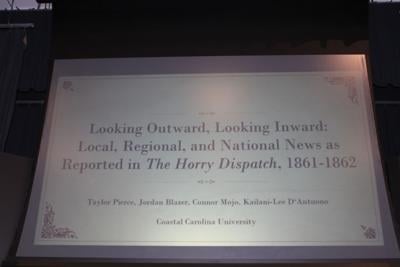When the first issue of Horry County’s first newspaper was published on March 4, 1861, the drums of war were beating in a nation divided over slavery.
And fair and balanced reporting was not on the agenda for the Horry Dispatch, an unabashed supporter of the Confederacy.
The newspaper was only four pages in length, with about half devoted to public notices and advertisements, according to Coastal Carolina University student Kailani-Lee D’Antuono. She is one of four students from CCU’s Prince Fellows program who did an award-winning deep dive into the available issues published in what was then known as Conwayborough.
The paper was produced through the spring of 1862, when publication ceased due to a scarcity of newsprint and supplies.
With less than 8,000 residents and widespread illiteracy, the demographics wouldn’t seem to support the publication of a weekly newspaper.
But the promise of war changed all that.
“Due to interest in secession and war, there became a market for a local newspaper,” CCU student and lifelong Myrtle Beach-area resident Taylor Pierce reported.
Some of the articles projected on the big screen in the McCown Auditorium might seem a bit shocking to modern-day Americans.
For example, a public notice advertised that a "negro male" would be sold at a sheriff’s sale to satisfy a debt of his owner.
An enslaved Black person was to stand trial for the poisoning of her mistress.
And residents were warned of counterfeit Confederate currency being circulated, with illustrations showing the difference between real and bogus bills.
But the news hole was mostly filled with stories reprinted from other publications, and dedicated to advancing the Confederate cause.
That includes an opinion piece from the London Post criticizing the Union’s blockade of the “world’s” port of Charleston on May 16, 1861, after the start of the war.
CCU student Jordan Blazer detailed a speech at the dedication of Fort Randall, an artillery emplacement protecting the Little River Neck, where a speaker encouraged residents to “leave the past behind; they were making the right choice."
Early issues also detailed troop movements, and reported “blazing speeches of a new civilization coming to be,” according to CCU junior Connor Mojo of Conway.
“Every (Confederate) victory was a devastating blow to the Union,” Mojo said, describing the coverage. Every defeat was “an injustice to civility that displays the barbaric nature of Yankee tyranny."
The students presented their findings at a lecture at the Horry County Museum in Conway on Feb. 8 to a group of about 50 local history buffs. Their catalogued database of articles will eventually be available to the public and scholars online.
It wasn’t as easy as searching for past articles on . The students had to deal with the poor condition of the newspapers, including missing issues and sections of illegible text.
What’s indisputable about the research is that the Dispatch was a voice of, and for, the Confederacy.
Horry County didn’t have as big a stake in the game as many districts in South Carolina, including adjacent Georgetown County.
According to the 1860 U.S. census, Pierce reported, Georgetown County had 18,253 slaves, 201 freed Black people, and just 2,193 whites. In Horry County, according to the 1850 census, whites outnumbered enslaved people by more than 2-to-1, with 5,522 whites and 2,073 enslaved Black people, plus 49 freed Black people.
In that era, when Horry County was a literal backwater, Conway and the rest of the remote and rural county had little to offer the rebel government in Richmond, Virginia, in the way of money and materials. Two-thirds of the farms in the county were valued at $600 or less, according to Pierce.
And the abolition of slavery would seemingly be of less concern to these small-farm freeholders of Horry County than it was to the rice plantation owners in adjacent Georgetown County.
“Horry County didn’t have much in the way of money or materials for the war effort. The one thing they could provide was men willing to die for the cause,” Mojo said.
It was a cause the Dispatch encouraged.
The paper reported that Lincoln intended to make the southern states U.S. territories if the union won the war, and revealed that the U.S. Senate had authorized the takeover of all telegraph lines in the South.
And the Dispatch published calls to arms, encouraging Horry County residents to serve the Confederacy by joining military units.
After students at the Citadel opened fire on Fort Sumter in Charleston on April 12, 1861, the Dispatch turned to coverage of the war.
“The Dispatch played an important role in providing citizens of Horry County mostly up-to-date military developments,” Mojo said.
But in the days before telephones and internet, news was slow to travel.
Mojo cited one instance — the Battle of Shiloh on April 6-7, 1862 — when the Dispatch described a rebel victory before the final buzzer, kind of like writing a Super Bowl story at halftime.
The Confederates forced a union retreat on April 6, but the Yankees rallied the next day in the bloodiest battle of the war to date.
The next issue was missing from the files, and Mojo said there’s no way to know if the final results were ever correctly reported.
At times, the fighting got close, putting a scare into county residents.
Mojo told of an incursion into the Georgetown area in May of 1862 by a ship commanded by a free slave. A rice plantation was reportedly burned, and Confederate flags were lowered.
The Dispatch reported that it took three days for the newspaper to ferret out of the truth.
But the news was often accompanied by verse bashing the Union cause. “The war waged by the U.S. upon the people of the Confederate States is unconstitutional and repugnant to civilization,” the Dispatch opined.
CCU History Professor John Navin introduced the students and praised them for their work. They won a research award at the 32nd Annual Symposium of the Society of Nineteenth Century Historians at Augusta University in Georgia in November 2024.
They also have or will present their findings at other events and meetings, including the Coastal Carolina University Humanities Week, the South Carolina Historical Association annual meeting, at the Osher Lifelong Learning Institute at UNC Wilmington, and at a regional conference of the Phi Alpha Theta history fraternity.
The students will also author an article for CCU magazine, and an exhibit is being considered for the county history museum, Navin said.
PDF’s of some of the issues of the Dispatch can be viewed here: historic .








(0) comments
Welcome to the discussion.
Log In
Keep it Clean. Please avoid obscene, vulgar, lewd, racist or sexually-oriented language.
PLEASE TURN OFF YOUR CAPS LOCK.
Don't Threaten. Threats of harming another person will not be tolerated.
Be Truthful. Don't knowingly lie about anyone or anything.
Be Nice. No racism, sexism or any sort of -ism that is degrading to another person.
Be Proactive. Use the 'Report' link on each comment to let us know of abusive posts.
Share with Us. We'd love to hear eyewitness accounts, the history behind an article.